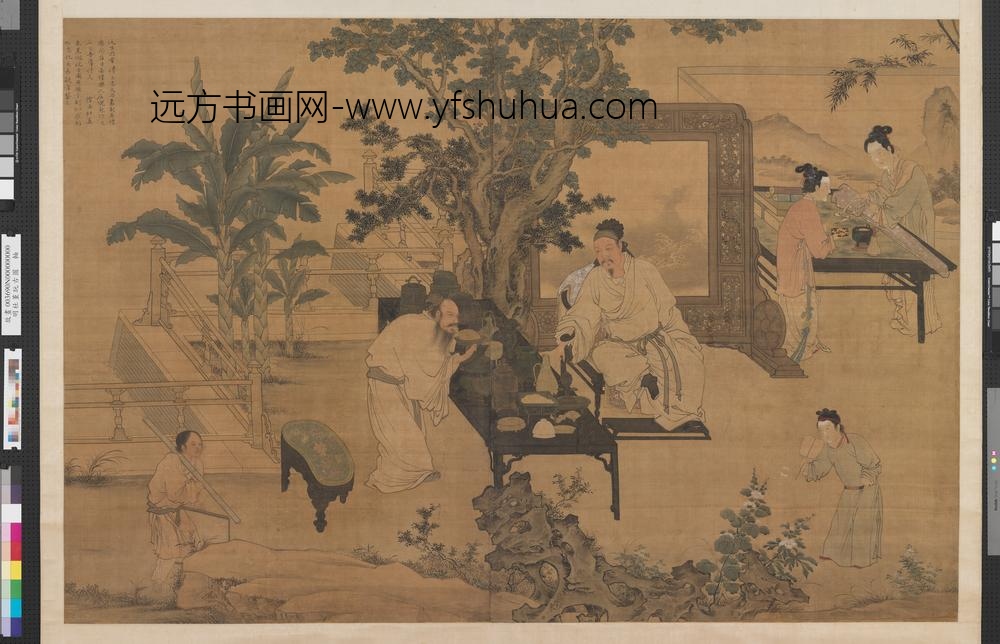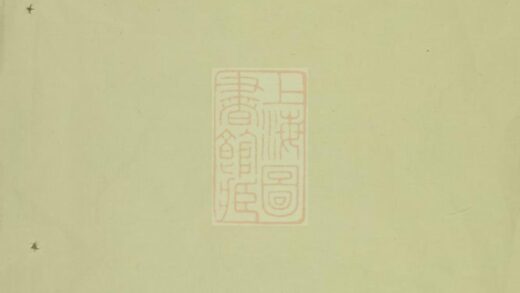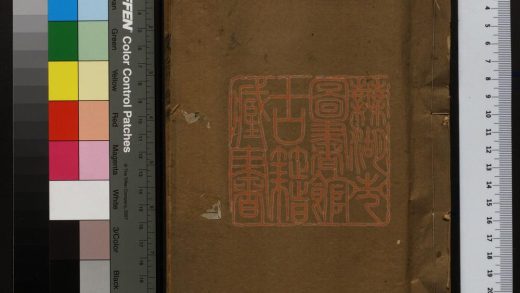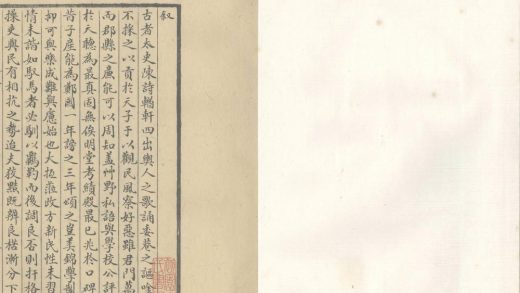【作品基本信息】
| 作者 | 杜堇 |
| 品名 | 玩古图图轴 |
| 朝代 | 明朝 |
| 文件大小 | 18.03MB |
| 分辨率(DPI) | 300×300 |
| 像素大小 | 3055×1968 |
| 尺寸(CM) | 25.86×16.66 |
| 作品数量 | 1 |
| 作品收藏 | 台北故宫博物院 |
| 图片格式 | 默认提供TIF和JPG两个版本 |
基本数据
| 藏品类型 | 绘画 |
| 品名 |
明杜堇玩古图 轴 Enjoying Antiquities |
| 分类 | 绘画 |
| 作者 | 杜堇;Du Jin |
| 数量 | 一轴 |
典藏尺寸
| 【位置】 | 【尺寸】(公分) |
| 本幅 | 126.1×187 |
质地
| 【质地位置】 | 【质地】 |
| 本幅 | 绢 |
题跋数据
| 【题跋类别】 | 【作者】 | 【位置】 | 【款识】 | 【书体】 | 【全文】 |
| 作者款识 | 杜堇 | 本幅 | 玩古乃常。博之志大。尚象制名。礼乐所在。日无礼乐。人反愧然。作之正之。吾有待焉。柽居杜堇。柬冕征玩古图并题。予则似求形外。意托言表。观者鉴之。 | 行书 |
主题
| 【主题类别】 | 【主题(第一层)】 | 【主题(第二层)】 | 【主题说明】 |
| 次要主题 | 山水 | 奇石 | |
| 次要主题 | 人物 | 侍从(侍女、童仆) | 侍女一、童仆一 |
| 次要主题 | 树木 | 柏 | |
| 次要主题 | 树木 | 竹 | |
| 次要主题 | 建筑 | 栏杆 | |
| 次要主题 | 建筑 | 庭院 | |
| 其他主题 | 草虫 | 蝶蛾 | 蝴蝶 |
| 次要主题 | 花草 | 蜀葵 | |
| 其他主题 | 花草 | ||
| 次要主题 | 树木 | 梧桐 | |
| 其他主题 | 器用 | 扇 | |
| 其他主题 | 器用 | 香炉.火盆 | 香炉 |
| 次要主题 | 器用 | 文玩(琴棋书画) | 琴、棋、书、画、青铜器、钟鼎、壶簋、瓷器、玳瑁盒 |
| 其他主题 | 器用 | 乐器 | |
| 其他主题 | 器用 | 花器 | |
| 其他主题 | 器用 | 家具(屏风) | 桌、椅、凳、屏风 |
| 次要主题 | 树木 | 芭蕉 | |
| 次要主题 | 人物 | 仕女 | 二人 |
| 主要主题 | 人物 | 高士(士人、隐士) | 二人 |
技法
| 【技法】 | 【技法细目】 |
| 工笔 | |
| 界画 | |
| 没骨 | |
| 皴法 | |
| 人物衣纹描法(粗细线条) | |
| 苔点 |
参考数据
| 【类别】 | 【参考数据】 |
| 收藏着录 | 故宫书画录(卷五),第三册,页330 |
| 收藏着录 | 故宫书画图录,第六册,页293-294 |
| 内容简介(中文) |
杜菫(约活动于公元一四六五—一五○五年),本姓陆,后改姓杜。丹徒(江苏镇江)人,寓居南京。字惧南,号柽居、古狂,又自署青霞亭长。成化初,举进士不第,遂绝意功名,专心于诗文、书画。 「玩古图」为双拼巨幅,原画可能曾被裱装成立屏。主题除了鉴赏古器,也在描写琴棋书画等文人的游艺活动。画风秀雅古朴,饶有南宋院体余韵。杜菫此型工笔人物画,对唐寅中期风格,深具影响。 |
| 内容简介(英文) |
Tu Chin was a native of Tan-t’u (modern Chen-chiang, Kiangsu) but later resided in Nanking. Early in the Ch’eng-hua era (ca. 1465), he took the civil service exams, but failed, devoting himself instead to poetry, writing, calligraphy, and painting. Originally, this work may have been 2 hanging scroll panels mounted as a standing screen. Representing the appreciation of antiquities, it depicts the leisurely activities of zither, chess, calligraphy, and painting associated with literati. The style is elegant and straightforward, much in the tradition of the Southern Sung (1127-1279) academic mode. Tu Chin’s fine brush style, as seen in the figures here, greatly influenced the style of T’ang Yin starting from the middle of his career. |
| 内容简介(中文) | 杜堇,约活动于成化(公元一四六五-一四八八)至弘治(一四八八-一五○五)年间。丹徒人,字惧南,一作耀南。号柽居,又号古狂。自称青霞亭长。成化初。应进士试不第。工诗文,通六书。善人物楼台,花草鸟兽。园亭之中,案陈彝鼎,取次鉴别。笔力秀劲。设色澹雅。款书亦甚雅秀。 |
| 内容简介(英文) |
Tu Chin was a native of Kiangsu. His style name was Chu-nan; his sobriquets were Ch’eng-chu and Ku-k’uang. He often called himself Ch’ing-hsia t’ing-chang. At the beginning of the Ch’eng-hua period (1465-1488), he took the examinations for the chin-shih degree, but failed. He was well-versed in poetry and belles-lettres as well as philology; and in painting excelled at figures, architecture, birds and flowers. This painting depicts a gathering of scholars for the enjoyment of studying antiquities. The brushwork is refined and firm, the colors elegant. Especially fine is the calligraphy of the artist’s signature. |
| 参考书目 |
1.国立故宫博物院编辑委员会,〈明杜堇玩古图〉,收入国立故宫博物院编辑委员会编,《界画特展图录》(台北:国立故宫博物院,1986年初版),页61。 2.刘芳如,〈明杜菫玩古图〉,收入国立故宫博物院编辑委员会编,《明中叶人物画四家特展-杜菫、周臣、唐寅、仇英》(台北:国立故宫博物院,2000年初版),页146-148。 3.〈明杜菫玩古图〉,收入刘芳如主编,《书画装池之美》(台北:国立故宫博物院,2008年初版一刷),页66。 4.李玉珉,〈杜堇玩古图〉,收入李玉珉主编,《古色:十六至十八世纪艺术的仿古风》(台北:国立故宫博物院,2003年初版),页229。 5.徐文琴,〈四海一家 —本院文物赴美参展「一四九二之际探险时代之艺术」图录专辑〉,《故宫文物月刊》,第103期(1991年10月),页8-9。 6.徐文琴,〈玩物思古 — 由杜堇「玩古图」看古代的文物收藏与鉴赏〉,《故宫文物月刊》,第104期(1991年11月),页22-29。 7.石守谦,〈浪荡之风 ─ 明代中期南京的白描人物画〉,《国立台湾大学美术史研究集刊》,第1期(1994),页39-61。 8.邱士华,〈明杜堇〈玩古图〉〉,《故宫文物月刊》,第350期(2012年5月),页70-76。 |
| 网页展示说明 |
图中器物: 《玩古图》桌案上的器物琳琅满目,除了墨绿色的青铜器外,另有白色、浅绿色以及带开片的瓷器、装饰着繁复纹样的金器等。乍看之下,件件似乎皆有来历。然若将器形、装饰图案的种类、纹饰的布局等细节与古器物图谱或各朝传世器比对,会发现杜堇所绘的器物,与夏、商、周三代,或是汉、唐盛世的古器物尽管类似,但总夹杂着若干佚离时代风格之处。推测画中这些器物的形象,可能是依据后世所制的仿古器所绘,也可能是杜堇按照自己原本对这些器物的认识,再掺入若干想象和创意的结果。 (20120410) |
| 网页展示说明 |
Antiques in the Painting: A wide assortment of antiques appears on the table in the painting “Enjoying Antiquities.” In addition to the dark green bronzes are white, light green, and crackled glaze porcelains as well as gold-ware decorated with complex patterns. At first glance, each piece seems to find its correlation with historical examples. However, close examination of the antiquities in terms of shape, decorative motif, and composition of the patterning, when compared with actual surviving examples over the ages or those found in ancient catalogues, shows that despite the superficial resemblance of Du Jin’s representations to examples from the Three Periods of High Antiquity (Xia, Shang, and Zhou dynasties) and the heyday of the Han and Tang dynasties, there are many examples of period style mixed in that do not seem to match. It appears that the forms of these antiquities might have been painted after later imitations or perhaps even rendered by Du Jin based on his understanding of actual objects combined with some imagination and innovation on his part. (20120410) |
| 网页展示说明 |
図中器物: 「玩古図」の机の上にはいろいろな品々が并べられています。青绿色の青铜器のほか、贯入の入った白や薄绿色の磁器、复杂な文様で装饰された金器などがあります。见たところ、それぞれに由来がありそうです。形や装饰図案の种类、文様の配置などを、古器物図谱や各时代の伝世品と比べると、杜菫の描いた器物は夏、殷、周の三代か、豊かに栄えた汉代や唐代の骨董品に似ていることに気づきますが、どこかその时代の风格とは异なっています。これはおそらく后世に作られた仿古品をもとに描いたからか、杜菫が自分の想象や创意を若干加えた结果ではないかと思われます。 (20120410) |
| 参考书目 | 浦莉安,〈明杜堇玩古图 轴〉,收入林丽江、何炎泉主编《写尽繁华-晚明文化人王世贞与他的志业》(台北:国立故宫博物院,2022.10),页132-133。 |
【作品展示】

__明杜堇玩古图.轴故画__KANPAA




